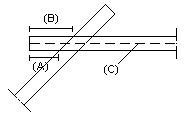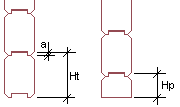Log Cross Section Library
Edit the cross section library in the database view. You can add a new cross section to the library by copying and editing the data of an existing cross section. Move the cursor over the row to be copied and select Edit > Copy Row from the menu bar of the database view. The program will add a new row to the database and copy the contents of the fields on the row you selected to the new row, excluding the code. Type a name for the cross section and fill in the rest of the parameters on the database view tabs.
Page 1
Page 2
Page 3
Page 1
- Code
- Type the name of the cross section in the Code field.
- Type
- Select the type from the list.
- Cross section, Accurate
- The shape of the cross section is defined using an application development program. Type the name of the application development program in the field. The program should be located in the ../proflibrary/log directory. The software developer offers the following application development programs:
- Cross section, Coarse
- The coarse shape of the cross section is always defined using the COARSELOG application development program. The program should be located in the ../Proflibrary/Log directory.
- Corner length
- Type the length of the log wall corner in the field. When you are adding a log wall with the profile in question selected as the log, the parameter value is set as the default corner length. Select the edge that determines the corner overlap in an oblique corner from the first list. Select one of the following as the measuring method from the list:
- Material
- This feature is not available in the log cross section library.
- Prog3d
- This feature is not available in the log cross section library.
Page 2
- Log dimensions
- Type the dimensions of the log cross section in the Width, Height and Net height fields.
- Notch
- The width of the crib is, by default, the same as the width of the log. If necessary, you can type a value for the crib width that is smaller or than larger than the log width. When the field is empty, the default value is used.
- Base log height
- Type the heights of the base log in the Full and Half fields. The Full height of the base log may be smaller than the Height of the log.
- Lumber
- Type the dimensions of the log billet in the Width and Height fields.
Page 3
The cross section properties on Tab 3 are not available in the log cross section library.

 If the type is not selected, it
will be determined by the code name.
If the type is not selected, it
will be determined by the code name.


